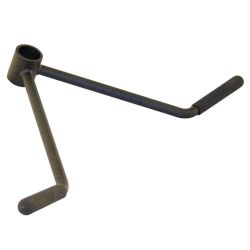04.19.11
The Reverse Hyperextension Machine
This machine, though confusing and intimidating at first sight, can be the power lifter’s best friend. If you’re struggling with squats, deadlifting, or even sprinting, the reverse hyper could be the answer to all your problems.

The Reverse Hyperextension machine
What’s it for?
- Glutes
- Hamstrings
- Lower middle back
- spine decompression
When should you use it?
The days you do deadlifting and days you do squats, supplement them with the reverse hyper after your main lifts.
The Basics
Resting your chest and stomach on the flat pad, you want to extend your legs backward, from a 90 degree angle to 180. The end of your motion should have you completely horizontal, think: Superman.
Your knees should be locked – this is vital to focusing the muscles it’s designed for. Your legs and back should be working and in motion the entire time, but the motion itself should be somewhat slow and smooth.
If you haven’t used it before, start without any weight on it! This is an advanced machine, and should not be approached lightly.
Do three to four sets of 10-25 reps whenever you do this. Start off with 10, and gradually increase the reps over a slow period, along with increasing the weight. Baby steps. You don’t become a champion in one weightlifting session.
Why use it?
There are many great machines and exercises out there that help build your glutes, hamstrings, or your back, but the reverse hyper is one of the only machines that actually decompresses your spine. When you deadlift or squat, your spine gets compressed. Over time, this can cause pain or lead to the potential for injury. The reverse hyper helps prevent any of this from happening.
04.18.11
Dead Lifting: The Pain
One of my favorite exercises, and one of the most painful to recover from, is the dead lift. The video provided on the link shows just about as good of advice as any expert could give on good form – check it out!

Call me masochistic, but this really is fun.
The real pain, however, is the lack of form most people use when dead lifting. I have seen some people whose backs contort to the point where watching them is painful. Nothing about doing a jerking motion with your back sounds or looks even remotely correct – or healthy.
Either drop the weight and use good form, or just don’t do the lift. Heavy weight means nothing when you rupture a disc in your back.
Only when you’ve gotten your form down should you start moving up to heavier weights. I stayed at 135 pound dead lifts for almost a month until I was comfortable with my form. Patience = strength.
Who knows, maybe if you get good enough form you could lift more than this guy:
04.17.11
WestSide Skull Crushers
Today I learned a new triceps workout, where you superset dumbbell Skull Crushers with seven sets for eight reps, and only 20 seconds of rest. With dumbbells, this proved to be a serious test of endurance.
One of the reasons for supersets with dumbbells is that it increases the stamina of your triceps drastically. A technique taught by guys at the WestSide gym, this is truly intense.
Though I have yet to post up on a how-to for Skull Crushers, I thought I would share my experience with what I’ve learned is an incredibly helpful triceps workout.
With only 20 seconds between each set, I had to recover my muscles as quickly as possible – or I’d never make it to the last set. By breathing rapidly between sets, I managed to barely scrape by, feeling an absolutely painful burn toward the end.
A good look at what a typical dumbbell Skull Crusher exercise looks like.
04.16.11
Squatting for Champs
The squat used to always be a feared exercise for me. My knees would hurt, my back would ache, and I would always feel like I was about to fall over.
After a few months training with Matt Makara, a grad student at Mason, I have come to love squatting. My form these days could pass any competition standards. Because I know many people must feel the way I used to about it, I want to share some tips on how you can get a better squat.
Starting from top to the bottom:
- Keep your head forward, looking and focusing as if you’re trying to see something in the distance.
- Place the bar as low on your shoulders as will comfortably and safely rest.
- Take deep breaths, and hold your breath during the squatting motion.
- While squatting, bend your knees outward (this will greatly help with the motion).
- Keep your toes pointed outward, and your feet resting a few inches past your shoulders.
- Rest the majority of the weight on your heels.
With these key tips, my comfort and strength squatting grew with each passing workout.
Here’s a video that provides a good visual demonstration:
04.15.11
Rowing with the Land Mine
Working out the other day with Matt Makara, another student at Mason, I was taught a new technique for doing bent over rows. The Land Mine provides a unique pivoting mobility that makes for a great bent over row workout.
Bending over, almost like in a stance for dead lifting, I did four sets of ten reps.

The exact grips you can find on the Land Mine at the RAC on Mason.
The funny thing about shoulder and back exercises, like the bent over row, is that you really won’t feel a soreness in your muscles after your workout. It’s the following days that indicate to you just how much you’ve worked. To me, this was never more intense than after my first day of using the Land Mine for rows.
Like this, but with the grips in the picture above.
04.14.11
Great Gear, but for Whom?

Tom O’Connor, the director of athletics at George Mason University, spoke in a press conference Thursday on campus. O’Connor is in his 16th year at GMU, and has over four decades of experience with other programs as well, including Dartmouth.
He provided many answers and opinions on the basketball team and with the department in general, but his experience and involvement showed its fringe when asked about certain equipment present in the gyms on campus. “I know some of the specialized equipment we have is for our athletes,” O’Connor said, “but I don’t definitively about all the equipment.”
These specialized pieces, normally seen at a power lifting gym or strongman facility, are both very expensive and hard to come by. The GHR, for example, ranges in price usually from $800 to over $2,000. Then there’s the reverse-hyper, which you’ll have to drop over $3,000 for. Bumper plates, which are weights designed for heavy impact lifting (deadlifting, clean and jerks, etc.) are a very expensive commodity as well.
It seems rather strange, then, that you can find two GHR’s at the RAC, two at the AFC, one at the Skyline, and several at the Field House. Student athletes generally work in the Field House, so why spend all the extra money putting this stuff – that most people don’t even know how to use – in each of the gyms?

The GHR, a.k.a. 'the leg killer.'
The bumper plates and reverse-hyper can be found in the RAC, which is also unusual. Bumper plates normally cost four to five dollars a pound (though the link here shows the cheapest ones you can find, which are still $22 for a 5lb plate)(, compared to $.50-.75 for regular plates. In a gym that mainly boasts light motion machines, where do these bumper plates fit in? The reverse-hyper machine is the most difficult piece of equipment to work with. It focuses on stretching your spine, so someone who isn’t familiar with it has a good chance of using it incorrectly (not good). For those who do know how to use it, it’s a saving grace. But, is it really useful for athletes – especially at the RAC?

The reverse-hyper.
Recently, a group of students, who do power lifting at the Field House, were upset when some of the specialized equipment was moved to the RAC when it was opened last year. The equipment was certainly not purchased to cater to these students, since there isn’t any funding or support of power lifting at GMU. With such a considerable amount of money used on this stuff, its unlikely any of it was purchased by the school without purpose.
It’s great that this stuff is here, and available for anyone to use, but the question remains: why?
04.07.11
Raging Bull Review

Jake La Motta
The 1980 boxing film, by Martin Scorsese, features Robert De Niro as a self-destructive boxer whose biggest fight ends up being with himself — one that he ultimately loses.
Based on the real life story of Jake LaMotta, a famous boxer in the 40’s, this movie closely parallels the anger and fear that drove LaMotta from superstar to prison life. Though his lack of self-esteem serves as an impetus to his boxing career, it was also the double-edged sword that destroys his life outside the ring.
Watching De Niro throughout the movie, its apparent how much was vested into taking on the role of LaMotta. From the beginning of the film to the end, De Niro himself gained around 100 pounds, which visually leaves a remarkable feeling of disgust and pity for the character. Being able to see him out of shape and at a loss in life leaves the viewer with an ending far from a fairy-tale.
With an angle that gives the audience a look at LaMotta’s personal life, without actually giving away any of his actual thoughts, Raging Bull is able to show a unique story. While its not exactly clear what is going through his head, LaMotta’s actions — especially with his wife Vickie — tell a story that would never be visible from the ring, from an interview, or even from one of those video biography stories.
The life of an athlete doesn’t always follow what they achieve in their sport, and Raging Bull is a prime example of just how different an athlete can be outside of the spotlight. The tragedy and pitiful nature Jake LaMotta met in life becomes an incredible experience in film.
In the moments leading up to the film’s end, and even after, I couldn’t help but wonder about any number of other athletes in history — in any sport — that have gone through such a struggle of life. Could there have been, or will there ever be a man or woman whose story could have such a passionate impact on me? Probably, but it might have to take another Scorsese monumental effort to prove it.
03.19.11
The Prowler…

The picture can't do the agony of using it justice.
Beware! This has to be the most sickening, exhausting, and intimidating piece of equipment I’ve ever used. The Prowler is not for beginners, nor for even the average athlete. The Prowler is serious.
What’s it for? (besides torture)
The Prowler offers a unique way to build explosive acceleration for running, hitting, pushing and endurance — all in one exercise.
When should you do it?
This equipment can be used before or after any workout. If you’re doing heavier lifting, use the Prowler after the workout. For those trying to build up muscle endurance, put the Prowling before your regular routine.
The Basics
Grip your hands around either the tall vertical poles or the low-stance grips (for an extra challenge: try using Grip4orce with the Prowler). Keeping your arms extended, push the Prowler at whatever speed you can take it. This can be done on pavement or turf, and at any desired distance. For strength building, try limiting your distance to about 25 yards, and keep the Prowler loaded with weight.
Fair warning with using the Prowler:
- You will get very light headed, BREATHE.
- Prepare to vomit after a few sets.
- After using the Prowler, you’ll be done for the day (with everything).
This video just shows you how hardcore the Prowler can be. I do NOT suggest anyone try both the weighted drag and loading the Prowler (again with the professionals).
03.10.11
Jim Iovino
Jim Iovino, managing sports editor for NBC in Washington, came in today, discussing an unique history of the early days of blogging.
Iovino started out writing for sports in college, and began one of the first blogs, which focused on the NHL. This blog actually become one of the first that was credentialed and had their writers allowed in to talk with the players in the locker room.
Iovino brought up a term new to our class, re-purposing, which involves compiling information from a more brick-and-mortar source to a new one.
Important points brought up by Iovino:
- Re-tweeting is important for sharing your tweets and introducing yourself to different groups of followers.
- Hockey teams are one of the biggest in sports in terms of reaching out to their communities, in particular teams like the Washington Capitals.
- Look at Dan Steinberg — his blog is unique in that it tells the reader something they don’t know. Coming up with new angles for stories can be what separates you as a sports writer from others.
02.10.11
‘Media Relations in Sport’ ch. 12 ‘Law and Ethics’
Summary
Chapter 12 informs the reader on the history of law and ethics in the U.S., and how it pertains to journalists and others in the communication field. A brief history of various constitutional rights and laws are shared, tied in to how the modern laws that directly affect the reporting of journalists and the sharing of information. The rights of athletes, politicians, and celebrities are drawn out in detail.
Copyright, Trademarks, Intellectual property, and patents are explained in a manner vital to the successful journalist, and how they must be approached.
With ethics, topics like: accountability, conflict of interest, accuracy, and various regulations and laws are explained.
Key Terms
SID- Sports information director
Defamation- slander or libel against a group or individual. Libel is written defamation, while slander is spoken.
Intellectual Property- Copyright, Trademarks, and patents all qualify as intellectual property.
Fair Use- news reporting, comments, research, or other educational uses of copyrighted work (“Limitations,” 2005).
FOIA- Freedom of Information Act; works to allow transparency and access to government information and databases.
Key Points
Elements of defamation can include
- statement made
- statement heard or published to at least one other person
- plaintiff identified in the statement (Carter et al., 2006)
People not considered ‘celebrities’ have more protection by the government from defamation and exploitation of private information than those who are (athletes, actors, certain corporations and companies).
Goverment in Sunshine Act – requires government agencies to keep meetings open to the public
FERPA and HIPPA- FERPA (Federal Educational Right to Privacy Act) provides protection to students from the disclosure of private records to those not given permission(“Family,” 2010). HIPAA (Health Insurance Portability and Accountability Act) allows disclosure of information deemed necessary for a patient’s care (Health information, 2010).